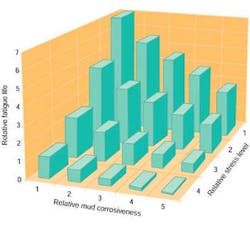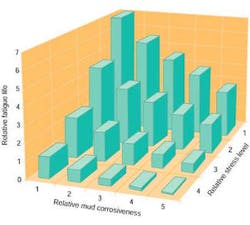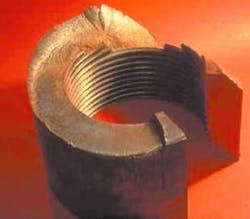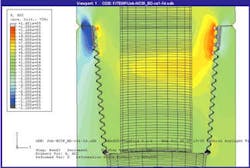DRILLING TECHNOLOGY - Part III: Drillstring fatigue prevention: 'From rules of thumb' to physics
PART III: This is Part III of a three-part series on purpose qualified drilling equipment. This segment focuses on tubular fatigue.
A 'purpose qualified' approach to inspect-ing and accepting drilling equipment means moving toward matching the attributes of the equipment to the loads we expect to apply. In the previous installment, we discussed how, using today's computer tools, a drillstring designer can reduce the probability of overload failure to nearly zero.
These tools, developed mostly in the last decade, with reasonable accuracy can predict the loads that a drillstring will encounter in virtually any planned hole. They greatly simplify the drillstring designer's problem with overstress, as they enable him in advance to set acceptance criteria for his inspector, and thus match the load capacity of his drilling equipment to predicted loads.
Unfortunately, fatigue is a different matter. Fatigue is progressive, irreversible localized structural damage that occurs when a component undergoes repeated stress cycles, usually at stress levels well below yield. It probably accounts for upward of eighty percent of all drill string failures.
Fatigue damage will accumulate at many high-stress points in the drillstring, and fatigue cracks will form. As stress cycles continue, these cracks grow until the affected component leaks or breaks, like the bottomhole assembly (BHA) box.
Fatigue failure will eventually occur, unless a drillstring inspector happens to catch the crack in time to prevent failure. The fatigue mechanism is understood by most children, as it is the universal method for breaking a wire coat hanger with the bare hands.
Stress cycles are an inevitable part of drilling. They occur when we rotate a component that is bent or buckled, and from vibration. Virtually every component we use has some accumulated fatigue damage from previous use, much like the accumulated miles on a used car's odometer. Unfortunately, there's no practical way of knowing how much fatigue has accumulated, no way of reading the tubular 'odometer,' until most of a component's life is exhausted. This makes inspection scheduling a critical but difficult-to-pin-down issue.
Despite our best efforts, estimating remaining life of a drillstring component from cumulative footage drilled or hours rotated has little practical merit. No two components, though they may have been identical when new, will undergo the same stress and environmental histories in service. Yet, it's these histories that will determine each component's fatigue life. Reasonable, everyday variations in many factors other than hours or footage can make a difference in real fatigue life up to several orders of magnitude. This leaves little hope that simplistic estimates based on footage drilled or hours rotated will be reliable enough to be useful.
To understand one of the main reasons why this is true, begin by examining how a drilling engineer designs for overload failure. Overload failure is governed by bulk stress in a component, which as we showed in the last installment is easy to estimate and design around. However, it's point stress, not bulk stress, that dominates fatigue behavior, and the complexity of calculating point stress in a drillstring component is daunting! This is due in part to the effects of stress concentrators (pits, notches, cuts) whose presence and severity are for the most part unknown.
Even simple, known stress concentrators like thread roots affect point stress to the degree that accurately estimating fatigue life is grossly complex. Stress effects of makeup torque and bending can be estimated using the latest finite element analysis (FEA) stress models. But what we find is that this single set of load conditions creates a range of pin neck point stress from zero to above yield strength at points on the same pin neck, points that are within a few inches of each other.
Now consider that there are several hundred other connections in the string, operating under different load conditions. And compound the problem with thousands of other stress concentrators, whose effects for the most part are even more difficult to quantify than thread roots.
While the problem of stress concentrators can be partly offset by approaches that employ fracture mechanics, fatigue life is also grossly affected by drilling mud chemical environment. The result is that even today's sophisticated computer-based fatigue life prediction models are unreliable, primarily because the models grossly oversimplify the calculation of actual stresses.
Additionally, because we don't know the deflection states of individual drillstring components, we can't plug representative 'end conditions' into the models. Finally, we have no knowledge of, nor method for, factoring in the effects of the myriad of drilling mud environments a component encounters over its life.
Rules-of-thumb
The upshot is that while our hypothetical engineer can virtually eliminate overload failure by applying flashy new technology, for fatigue design, he or she has only a few tired old qualitative 'rules-of-thumb:'
- 'Balance' BHA connections by forcing bending strength ratio into desired ranges
- Smooth the drillstring with transition pipe sections.
- Cut stress relief features on BHA connection threads, and stabilize the BHA as much as practical.
- Monitor vibrations and change bit weight, rotary speed and BHA design to minimize them.
- Design and operate the drillstring to prevent buckling in such components as drill pipe and jars.
While these design rules-of-thumb are useful, costly drillstring fatigue failures are still an ordinary part of the business. We simply do not posses the technology to design our way around fatigue failures.
It's unlikely that we'll be able to totally eliminate drillstring fatigue failure in this generation. The mechanism is too complex, the models too inexact, the end conditions too unknown, and the economic justification too thin. However, two technological 'step outs' that are within reach can give the drill string designer the ability to drastically curtail the fatigue mechanism.
First goal
In order to operate at lower stress, we need to address fatigue prevention in the same context we presently use for overload design. For overload design, the drilling engineer (1) predicts the loads the drillstring will need to carry, and (2) configures a drillstring that can carry the predicted loads, with a safety factor to handle uncertainty.
In essence, overload failure requirements are met as soon as the engineer finds any single drill string that satisfies the second point cited in the preceding paragraph. Now he or she is free to examine other drillstring design needs, such as directional control and hydraulics. To retard fatigue however, the drilling engineer needs to modify the second step in a simple but important way.
The second part of this first goal is to find the drillstring that will carry the predicted loads at the lowest stress, with a safety factor to handle uncertainty: This statement has profound implications for the design process. It means that the designer is not finished once he satisfies the overload requirements, but must continue searching for other alternatives.
In essence, the design is not optimized from a fatigue standpoint until the engineer has identified the lowest stress practical alternative which meets all other objectives.
Second goal
The second goal is to operate in more benign environments. We choose our drilling mud systems for a variety of very important reasons. One important mud attribute we generally ignore however is its corrosiveness. Yet, along with increasing stress, increasing corrosiveness plays havoc with a drillstring component's fatigue life.
Indeed, the combined effects of these two factors can easily alter component fatigue life by one or two orders of magnitude, without ever getting out of what might be considered "ordinary" operating ranges for today's drilling.
Needs
It's easy to show the fatigue benefits of lower operating stress and more benign environments. It's a different matter to give a drilling engineer specific rules to follow to achieve these benefits. What we as an industry must do to seriously impact the problem of drill string fatigue is the following.
Quantify the point-stress effects of everyday drill string design decisions: where we place stabilizers; how much transition pipe we run; what acceptance criteria our inspectors use for fatigue-related flaws like slip cuts and stabilizer neck length; and a hundred other everyday choices we're now making on 'rules of thumb' or out of habit.
This will enable the designer to make choices that both meet drilling objectives and reduce operating stress. The need for this has long been evident. The problem, and main reason we have not done this yet, is that doing it will be a monumental task. To gain an appreciation of the difficulty, look again at the stress distribution inside the example pin neck.
Another task is to implement a standard measure for mud corrosiveness. Make this one of the attributes upon which we select our mud systems. Other things equal, the best mud for fatigue mitigation is the one that's the least corrosive.



